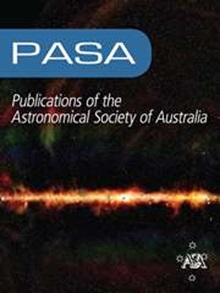中央冗余阵列兆瓦级(CRAM)的系统设计和验证
IF 4.6
3区 物理与天体物理
Q1 ASTRONOMY & ASTROPHYSICS
Publications of the Astronomical Society of Australia
Pub Date : 2024-04-19
DOI:10.1017/pasa.2024.33
引用次数: 0
摘要
探索宇宙黎明期和电离纪元(EoR)的 21 厘米信号可以揭开早期宇宙的神秘面纱,当时第一批恒星和星系分别诞生和电离。然而,21 厘米信号非常微弱,因此在明亮前景中进行探测极具挑战性。默奇森宽视场阵列(MWA)旨在测量早期宇宙中性氢的亮度温度波动。MWA 望远镜观测射电天空时具有很大的视场(FoV),这会导致明亮的星系,尤其是地平线附近的星系,污染测量结果。这些污染 EoR 数据集的前景必须经过精心去除或处理,才能成功探测到信号。中央冗余阵列兆瓦(CRAM)是一个天顶指向型新仪器,安装在 MWA 第二阶段南六边形配置的中心,由 64 个偶极子组成,呈 8 × 8 配置,在所考虑的每个频率上,其视场角都是 MWA 宽度的一半。这一新仪器的主要目标是根据减小的主波束形状来减轻场中心附近明亮射电源的影响,并通过较大阵列配置的减小侧叶响应来减少地平线附近前景源的污染。在本文中,我们将向公众介绍这台新仪器,并介绍仪器的系统结构和特点。利用首照观测,我们确定了 CRAM 系统的温度和系统性能。本文章由计算机程序翻译,如有差异,请以英文原文为准。
System design and validation of Central Redundant Array Mega-tile (CRAM)
Exploration of the 21cm signal during the Cosmic Dawn and the Epoch of Reionisation (EoR) can unravel the mysteries of the early Universe when the first stars and galaxies were born and ionised, respectively. However, the 21cm signal is exceptionally weak, and thus, the detection amidst the bright foregrounds is extremely challenging. The MurchisonWidefield Array (MWA) aims to measure the brightness temperature fluctuations of neutral hydrogen from the early Universe. The MWA telescope observes the radio sky with a large Field of View (FoV) that causes the bright galaxies, especially near the horizon, to contaminate the measurements. These foregrounds contaminating the EoR datasets must be meticulously removed or treated to detect the signal successfully. The Central Redundant Array Mega-tile (CRAM) is a zenith-pointing new instrument, installed at the centre of the MWA Phase II southern hexagonal configuration, comprising of 64 dipoles in an 8 × 8 configuration with a FoV half the width of the MWA’s at every frequency under consideration. The primary objective of this new instrument is to mitigate the impact of bright radio sources near the field centre in accordance with the reduced primary beamshape and to reduce the contamination of foreground sources near the horizon with the reduced sidelobe response of the larger array configuration. In this paper, we introduce the new instrument to the community and present the system architecture and characteristics of the instrument. Using the first light observations, we determine the CRAM system temperature and system performance.
求助全文
通过发布文献求助,成功后即可免费获取论文全文。
去求助
来源期刊
CiteScore
5.90
自引率
9.50%
发文量
41
审稿时长
>12 weeks
期刊介绍:
Publications of the Astronomical Society of Australia (PASA) publishes new and significant research in astronomy and astrophysics. PASA covers a wide range of topics within astronomy, including multi-wavelength observations, theoretical modelling, computational astronomy and visualisation. PASA also maintains its heritage of publishing results on southern hemisphere astronomy and on astronomy with Australian facilities.
PASA publishes research papers, review papers and special series on topical issues, making use of expert international reviewers and an experienced Editorial Board. As an electronic-only journal, PASA publishes paper by paper, ensuring a rapid publication rate. There are no page charges. PASA''s Editorial Board approve a certain number of papers per year to be published Open Access without a publication fee.

 求助内容:
求助内容: 应助结果提醒方式:
应助结果提醒方式:


